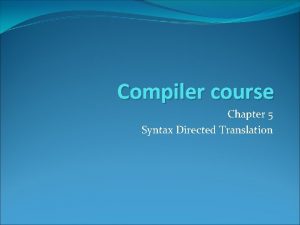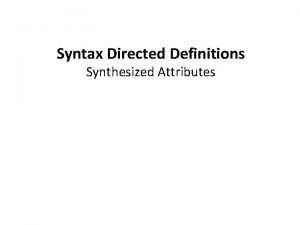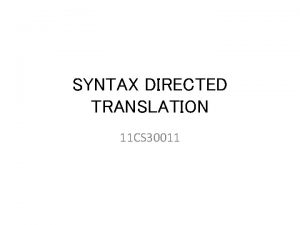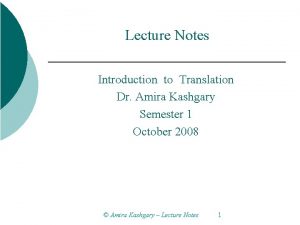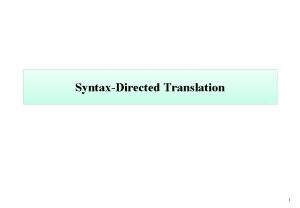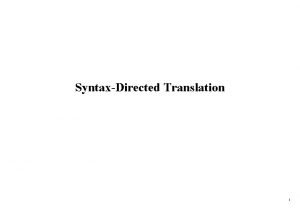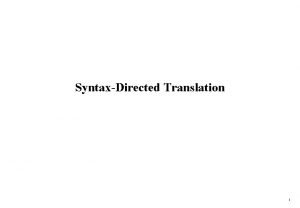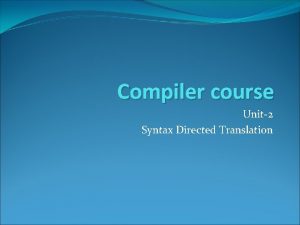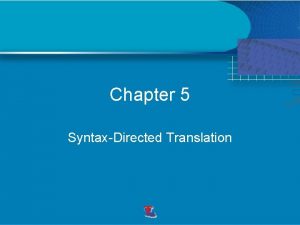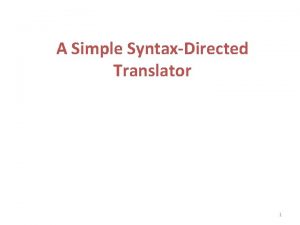Lecture 16 Chapter 5 Syntax Directed Translation SyntaxDirected









- Slides: 9

Lecture # 16 Chapter # 5: Syntax Directed Translation

Syntax-Directed Translation • Uses a CFG to specify the syntactic structure of the language • It associates a set of attributes with the terminals and nonterminals of the grammar • It associates with each production a set of semantic rules to compute values of attributes • A parse tree is traversed and semantic rules applied: after the computations are completed the attributes contain the translated form of the input 2

Synthesized and Inherited Attributes • An attribute is said to be … – synthesized if its value at a parse-tree node is determined from the attribute values at the children of the node – inherited if its value at a parse-tree node is determined by the parent (by enforcing the parent’s semantic rules) 3

Syntax-Directed Definitions • A syntax-directed definition (or attribute grammar) binds a set of semantic rules to productions • Terminals and nonterminals have attributes holding values set by the semantic rules • A depth-first traversal algorithm traverses the parse tree thereby executing semantic rules to assign attribute values • After the traversal is complete the attributes contain the translated form of the input 4

Example Attribute Grammar Production Semantic Rule L En E E 1 + T E T T T 1 * F T F F (E) F digit print(E. val) E. val : = E 1. val + T. val E. val : = T 1. val * F. val T. val : = F. val : = E. val F. val : = digit. lexval Note: all attributes in this example are of 5 the synthesized type

Depth-First Traversals (Example) L print(16) E. val = 16 E. val = 14 T. val = 2 E. val = 9 T. val = 5 T. val = 9 F. val = 5 F. val = 9 9 + 5 + 2 n Note: all attributes in this example are of 6 the synthesized type

Example Attribute Grammar String concat operator Production Semantic Rule expr 1 + term expr 1 - term expr term 0 term 1 … term 9 expr. t : = expr 1. t // term. t // “+” expr. t : = expr 1. t // term. t // “-” expr. t : = term. t : = “ 0” term. t : = “ 1” … term. t : = “ 9” 7

Example Annotated Parse Tree expr. t = “ 95 -2+” expr. t = “ 95 -” expr. t = “ 9” term. t = “ 2” term. t = “ 5” term. t = “ 9” 9 - 5 + 2 8

Depth-First Traversals procedure visit(n : node); begin for each child m of n, from left to right do visit(m); evaluate semantic rules at node n end 9
 Syntax of mkleaf is
Syntax of mkleaf is Evaluation orders for sdd's
Evaluation orders for sdd's Syntax directed defination
Syntax directed defination Syntax directed definition
Syntax directed definition 01:640:244 lecture notes - lecture 15: plat, idah, farad
01:640:244 lecture notes - lecture 15: plat, idah, farad Translation studies lecture notes
Translation studies lecture notes Communicative translation meaning
Communicative translation meaning Number translation using voice translation profiles
Number translation using voice translation profiles Transformation of functions
Transformation of functions Noun phrase
Noun phrase

